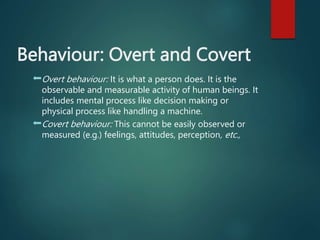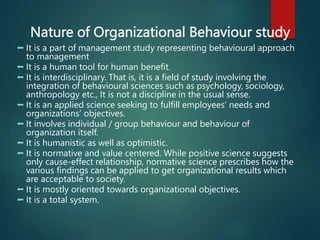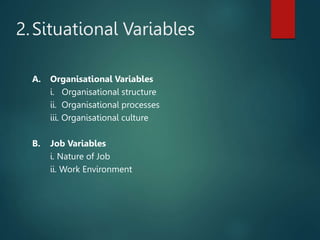This document discusses organizational behaviour and individual behavior within organizations. It defines an organization as a consciously coordinated social unit composed of two or more people working together to achieve common goals. Behavior is influenced by both individual factors like personality, skills, and attitudes as well as situational factors like work environment and job characteristics. Organizational behavior aims to describe, understand, predict, and control human behavior in organizational settings to improve organizational effectiveness. Key aspects that influence individual behavior include physiological traits, socio-psychological characteristics, personality factors, and the situational context.


![Characteristics of an
Organization
An organization is created deliberately or consciously. Anything which is formed as a natural sequence such
as a family or a tribal group may not be termed as an organization. Typical organizations are manufacturing
companies, marketing firms, trading houses, transport offices, banks, colleges, hotels, hospitals, etc.,
It is composed of two or more people. Any business run by one individual cannot be termed as a business
organization. In large organizations the number of people runs into lakhs.
There is co-ordination among the people working in an organization. In the absence of co-ordination/co-
operation among the people the organization gets disorganized and ceases to exist.
There is hierarchy in any organization. A typical hierarchy consists of Board of Directors, Chairman,
Managing Director, General Managers, Dy. General Managers, Senior Managers, Managers, Supervisors and
Workers in a large manufacturing firm. Principal, Heads of Departments, Professors, Associate Professors
and Asst. Professors form the hierarchy in a professional college. Each level of hierarchy will have its own
authority and responsibility.
Organizations function continuously. There are business houses existing for over centuries. In certain cases
the business may be seasonal [selling of crackers, marketing of a particular variety of fruit and etc.,] but still
it is organized business.
organization will have certain goal(s). For a hospital, the goal could be to offer quality medical service at an
affordable cost. A star hotel’s goal could be to offer a luxurious stay. The goal of a management school
could be to make the students industry-ready. Depending on the top management the goals of a
corporate could be to offer quality goods/service, invent newer and newer product designs, sell products at
the cheapest rate or make available its services round the clock. Every
Show Picture](https://image.slidesharecdn.com/ob-230620004057-c696d97d/85/OB-pptx-3-320.jpg)
![Behaviour
Behaviour is a response to a stimulus which is observed
directly or indirectly. Human behaviour is a function of
person and environment i.e. B=f [PxE].
“Person” includes education, skills, experience, health,
gender, age, attitude, aptitude, beliefs, perception,
personality, etc., Environment covers working
conditions, amenities, supervision, rewards, fellow
workers, motivation etc.](https://image.slidesharecdn.com/ob-230620004057-c696d97d/85/OB-pptx-4-320.jpg)



![Goals of Organizational Behaviour Study
The goals of understanding organizational
behavior are
to describe [how people behave under a variety of
conditions /environments?]
to understand[why people behave as they do in
different situations?]
to predict [how people behave in future?] and
to control [how their behaviour is controlled or
managed for productive activity]
Show picture](https://image.slidesharecdn.com/ob-230620004057-c696d97d/85/OB-pptx-8-320.jpg)















